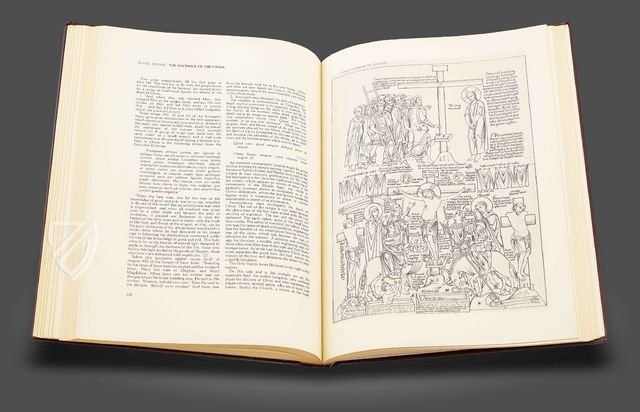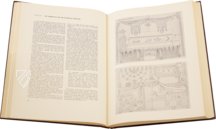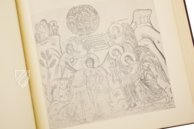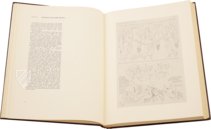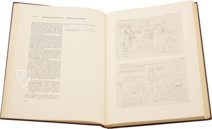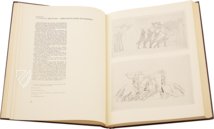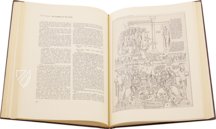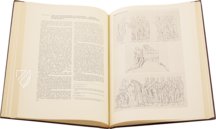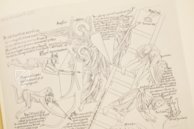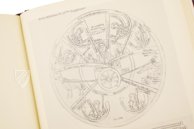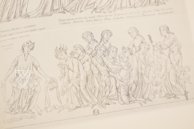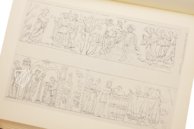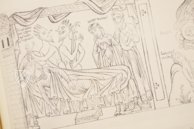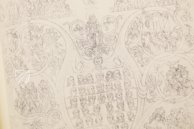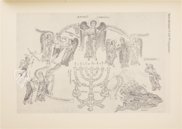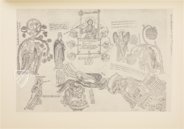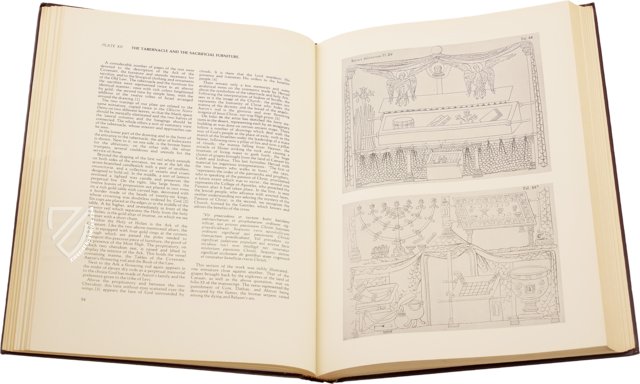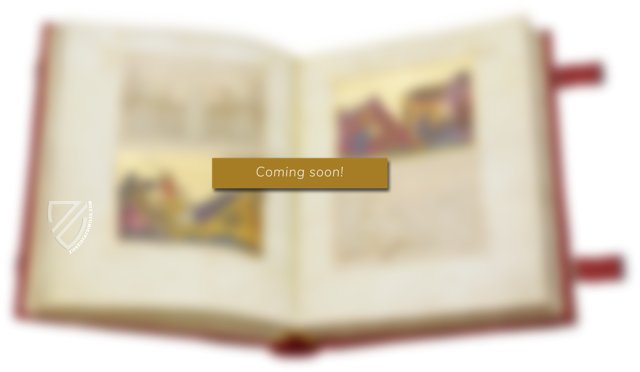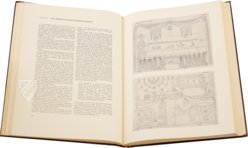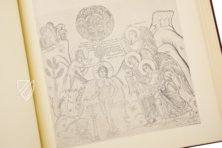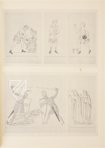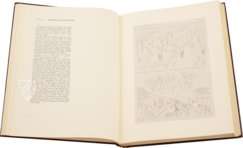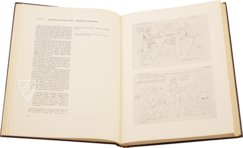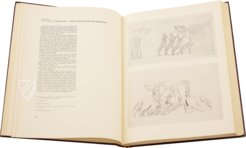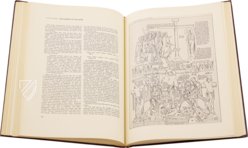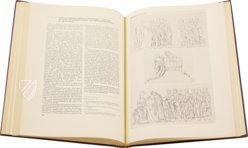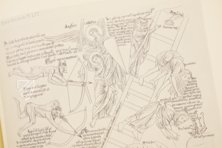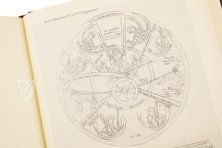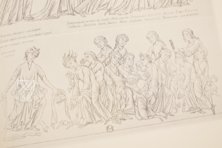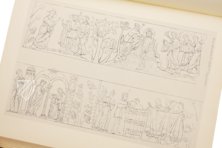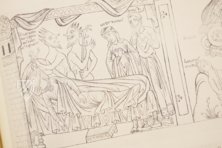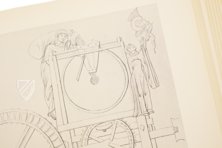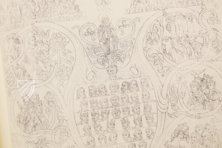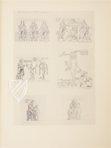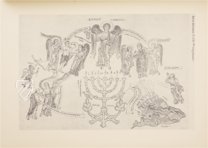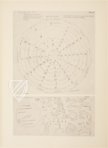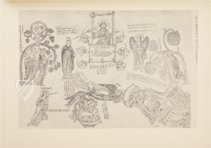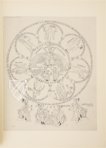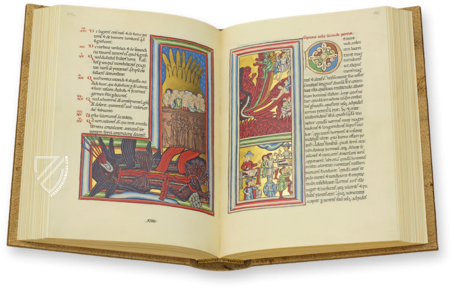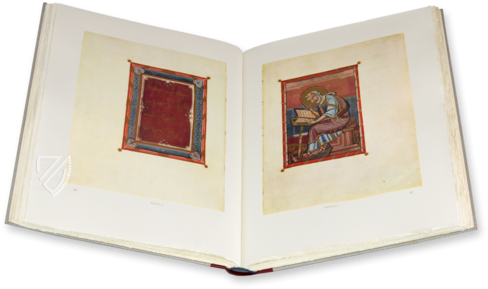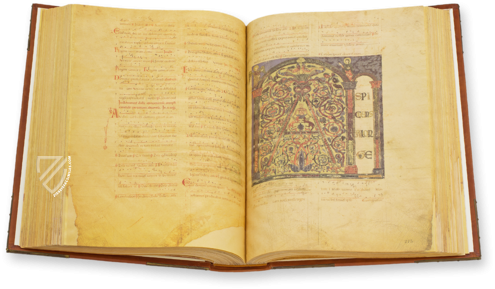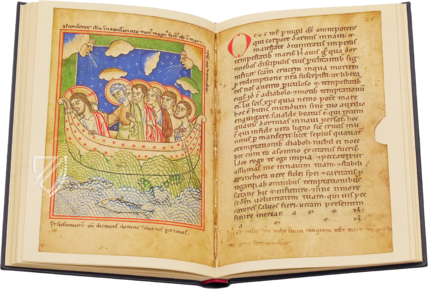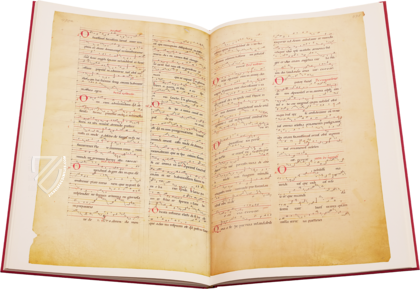Hortus Deliciarum
(1,000€ - 3,000€)
A 12th century encyclopedia that is both the first to be written by a woman and also represents one of the oldest sources of polyphonic music: the Hortus deliciarum or “Garden of Delights” by Abbess Herrad of Landsberg** (ca. 1130-1195). The manuscript, created between 1167 and 1185, represents a comprehensive survey of knowledge available in the 12th century that ranges from classical authors from antiquity to Arab scholars. Theology, philosophy, history, literature, and more are all covered in the massive text, which originally included at least 336 miniatures. Although the original was destroyed in 1870 during the course of the Franco-Prussian War, various researchers created copies of both the miniatures and text so that the majority of the work has been preserved to the present.
Hortus Deliciarum
The Hortus deliciarum or “Garden of Delights” is an illuminated medieval encyclopedia commissioned by Herrad of Landsberg (ca. 1130-1195), an Alsatian nun and abbess of Hohenburg Abbey in the Vosges Mountains. Work on the manuscript, one of the most celebrated works of the period, began in 1167 and lasted almost 20 years before being completed in 1185. Most of the contents are not original creations but rather a compendium of knowledge from other 12th century works ranging from poems to illustrations and music. Primarily written in Latin with some glosses in German, it draws on sources ranging from classical to Arab authors. Herrad’s own poems, which are addressed to other nuns and would have been set to music, are interspersed throughout the text.
Abbess Herrad of Landsberg
Born at Landsberg castle, the seat of her Alsatian noble family, at a young age Herrad entered Hohenburg Abbey, located about 15 miles outside of Strasbourg. Hohenburg was being run by Abbess Relindis (d. 1167), who enjoyed the support of the Holy Roman Emperor Frederick I (1122-90) and had been sent from the Benedictine monastery of Bergen in Bavaria to revive the institution. Thanks to this imperial patronage, the abbey thrived and became a powerful center for reform that also offered the most comprehensive education that was available to women during the 12th century. Herrad succeeded Relindis as abbess upon her death in 1167 and continued the work of rebuilding the monastery and consolidating its lands for the next 28 years. She is remembered as being both capable and well-loved by the nuns of Hohenberg.
A 12th Century Encyclopedia
Herrad may have begun work on her epic tome as early as 1159, in which she examines the battle between Virtue and Vice. Originally consisting of 324 parchment sheets folded in two, the Latin text was accompanied by ca. 1,250 glosses in German and 336 miniatures of various sizes. Aside from being the first encyclopedia written by a woman, the manuscript is also one of the oldest sources of polyphony and contains at least 20 song texts, all of which originally featured neume notation and four-line staves The illustrations show a rare degree of artistic imagination and included many symbolic representations of theological, philosophical, historical, and literary themes. Although the work of many hands, the content appears to have been mostly compiled, written, and edited by Herrad who appears to have directed the artists in illustrating the work as well. In the early 19th century, the manuscript was transferred to the municipal library of Strasbourg where it could be studied by lay scholars.
Destruction in the Franco-Prussian War
During the Siege of Strasbourg in the summer of 1870, the city endured heavy artillery bombardment and as a result, the library housing the Hortus deliciarum caught on fire and the manuscript was burnt as a result. Thankfully, portions of the manuscript had been copied at various times allowing for its reconstruction: the miniatures had been copied in 1818 by Christian Maurice Engelhardt while the text was copied and published by Straub and Keller between 1879 and 1899. It is due to the foresight of these academics and researchers that the priceless work has survived to the present.
Codicology
- Alternative Titles
- Hortus Deliciarum of Herrad of Landsberg (or Hohenbourg)
- Size / Format
- Ca. 648 pages / 50.0/53.0 × 36.0/37.0 cm
- Origin
- France
- Date
- Last quarter of the 12th century
- Epochs
- Style
- Genre
- Script
- Protogothic minuscule
- Illustrations
- 136 large miniatures; 5 half page miniatures; 11 illustrated text pages; 2 full page drawings; 5 calendar tables; 1 tabular family tree
- Content
- Encyclopedia of the theological and profane knowledge of the time, compiled from Arabic and classical sources. Poetry and music.
- Artist / School
- Herrad of Landsberg (author)
Hortus Deliciarum
Temple Menorah
The original menorah with seven lamps was made of pure gold for the tabernacle and was later set up in Solomon’s Temple. The Arch of Titus depicts Roman legionaries carrying the menorah from the Second Temple after the capture of Jerusalem in AD 70. It was taken by the Vandals during the sack of Rome in 455 and was recovered from their capital of Carthage by Belisarius in 533, who brought it to Constantinople. It then disappeared from the historical record, but some claim it is hidden in the Vatican.
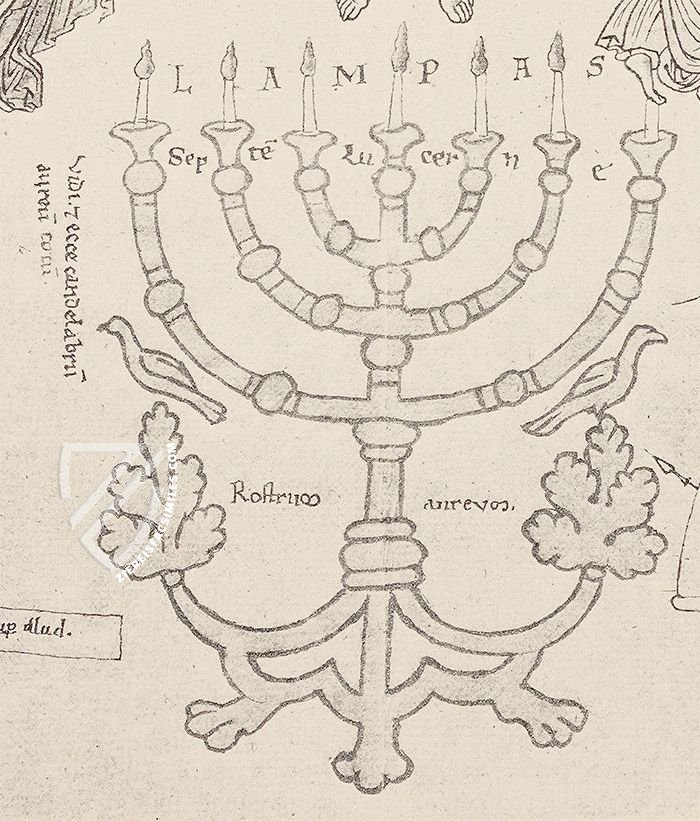
Hortus Deliciarum
Philosophy and the Seven Liberal Arts
Philosophy, embodied by a female figure holding a scroll and wearing a crown consisting of three human faces, is enthroned in the midst of the Seven Liberal Arts, which are also personified. The two male scribes depicted below Philosophy are labelled “Socrates” and “Plato” while their four colleagues at the bottom of the page are labelled “Poets or Magicians”.
The miniature takes the form of a rose window in a cathedral and represent the circle of philosophy. Beginning at the top and going clockwise, the figures represent grammar, rhetoric, logic, arithmetic, geometry, and astronomy. The first three comprise the trivium, the lower division of the Liberal Arts, while the next four belong to the quadrivium, which are taught after the trivium.
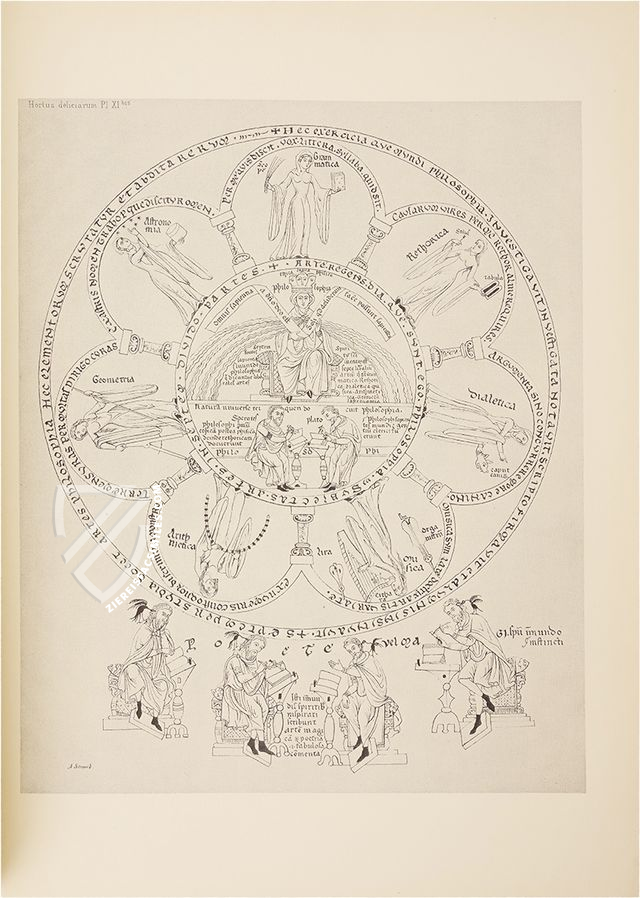
#1 Hortus Deliciarum
Languages: English, French
(1,000€ - 3,000€)
#2 Hortus Deliciarum
Language: English
(under 1,000€)
- Treatises / Secular Books
- Apocalypses / Beatus
- Astronomy / Astrology
- Bestiaries
- Bibles / Gospels
- Chronicles / History / Law
- Geography / Maps
- Saints' Lives
- Islam / Oriental
- Judaism / Hebrew
- Single Leaf Collections
- Leonardo da Vinci
- Literature / Poetry
- Liturgical Manuscripts
- Medicine / Botany / Alchemy
- Music
- Mythology / Prophecies
- Psalters
- Other Religious Books
- Games / Hunting
- Private Devotion Books
- Other Genres
- Afghanistan
- Armenia
- Austria
- Belgium
- Belize
- Bosnia and Herzegovina
- China
- Colombia
- Costa Rica
- Croatia
- Cyprus
- Czech Republic
- Denmark
- Egypt
- El Salvador
- Ethiopia
- France
- Germany
- Greece
- Guatemala
- Honduras
- Hungary
- India
- Iran
- Iraq
- Israel
- Italy
- Japan
- Jordan
- Kazakhstan
- Kyrgyzstan
- Lebanon
- Liechtenstein
- Luxembourg
- Mexico
- Morocco
- Netherlands
- Palestine
- Panama
- Peru
- Poland
- Portugal
- Romania
- Russia
- Serbia
- Spain
- Sri Lanka
- Sweden
- Switzerland
- Syria
- Tajikistan
- Turkey
- Turkmenistan
- Ukraine
- United Kingdom
- United States
- Uzbekistan
- Vatican City
- A. Oosthoek, van Holkema & Warendorf
- Aboca Museum
- Ajuntament de Valencia
- Akademie Verlag
- Akademische Druck- u. Verlagsanstalt (ADEVA)
- Aldo Ausilio Editore - Bottega d’Erasmo
- Alecto Historical Editions
- Alkuin Verlag
- Almqvist & Wiksell
- Amilcare Pizzi
- Andreas & Andreas Verlagsbuchhandlung
- Archa 90
- Archiv Verlag
- Archivi Edizioni
- Arnold Verlag
- ARS
- Ars Magna
- ArtCodex
- AyN Ediciones
- Azimuth Editions
- Badenia Verlag
- Bärenreiter-Verlag
- Belser Verlag
- Belser Verlag / WK Wertkontor
- Benziger Verlag
- Bernardinum Wydawnictwo
- BiblioGemma
- Biblioteca Apostolica Vaticana (Vaticanstadt, Vaticanstadt)
- Bibliotheca Palatina Faksimile Verlag
- Bibliotheca Rara
- Boydell & Brewer
- Bramante Edizioni
- Bredius Genootschap
- Brepols Publishers
- British Library
- C. Weckesser
- Caixa Catalunya
- Canesi
- CAPSA, Ars Scriptoria
- Caratzas Brothers, Publishers
- Carus Verlag
- Casamassima Libri
- Centrum Cartographie Verlag GmbH
- Chavane Verlag
- Christian Brandstätter Verlag
- Circulo Cientifico
- Club Bibliófilo Versol
- Club du Livre
- CM Editores
- Collegium Graphicum
- Collezione Apocrifa Da Vinci
- Comissão Nacional para as Comemorações dos Descobrimentos Portugueses
- Coron Verlag
- Corvina
- CTHS
- D. S. Brewer
- Damon
- De Agostini/UTET
- De Nederlandsche Boekhandel
- De Schutter
- Deuschle & Stemmle
- Deutscher Verlag für Kunstwissenschaft
- DIAMM
- Droz
- E. Schreiber Graphische Kunstanstalten
- Ediciones Boreal
- Ediciones Grial
- Ediclube
- Edições Inapa
- Edilan
- Editalia
- Edition Deuschle
- Edition Georg Popp
- Edition Leipzig
- Edition Libri Illustri
- Editiones Reales Sitios S. L.
- Éditions de l'Oiseau Lyre
- Editions Medicina Rara
- Editorial Casariego
- Editorial Mintzoa
- Editrice Antenore
- Editrice Velar
- Edizioni Edison
- Egeria, S.L.
- Eikon Editores
- Electa
- Emery Walker Limited
- Enciclopèdia Catalana
- Eos-Verlag
- Ephesus Publishing
- Ernst Battenberg
- Eugrammia Press
- Extraordinary Editions
- Fackelverlag
- Facsimila Art & Edition
- Facsimile Editions Ltd.
- Facsimilia Art & Edition Ebert KG
- Faksimile Verlag
- Feuermann Verlag
- Folger Shakespeare Library
- Franco Cosimo Panini Editore
- Friedrich Wittig Verlag
- Fundación Hullera Vasco-Leonesa
- G. Braziller
- Gabriele Mazzotta Editore
- Gebr. Mann Verlag
- Gesellschaft für graphische Industrie
- Getty Research Institute
- Giovanni Domenico de Rossi
- Giunti Editore
- Graffiti
- Grafica European Center of Fine Arts
- Guido Pressler
- Guillermo Blazquez
- Gustav Kiepenheuer
- H. N. Abrams
- Harrassowitz
- Harvard University Press
- Helikon
- Hendrickson Publishers
- Henning Oppermann
- Herder Verlag
- Hes & De Graaf Publishers
- Hoepli
- Holbein-Verlag
- Houghton Library
- Hugo Schmidt Verlag
- Idion Verlag
- Il Bulino, edizioni d'arte
- ILte
- Imago
- Insel Verlag
- Insel-Verlag Anton Kippenberger
- Instituto de Estudios Altoaragoneses
- Instituto Nacional de Antropología e Historia
- Introligatornia Budnik Jerzy
- Istituto dell'Enciclopedia Italiana - Treccani
- Istituto Ellenico di Studi Bizantini e Postbizantini
- Istituto Geografico De Agostini
- Istituto Poligrafico e Zecca dello Stato
- Italarte Art Establishments
- Jan Thorbecke Verlag
- Johnson Reprint Corporation
- Josef Stocker
- Josef Stocker-Schmid
- Jugoslavija
- Karl W. Hiersemann
- Kasper Straube
- Kaydeda Ediciones
- Kindler Verlag / Coron Verlag
- Kodansha International Ltd.
- Konrad Kölbl Verlag
- Kurt Wolff Verlag
- La Liberia dello Stato
- La Linea Editrice
- La Meta Editore
- Lambert Schneider
- Landeskreditbank Baden-Württemberg
- Leo S. Olschki
- Les Incunables
- Liber Artis
- Library of Congress
- Libreria Musicale Italiana
- Lichtdruck
- Lito Immagine Editore
- Lumen Artis
- Lund Humphries
- M. Moleiro Editor
- Maison des Sciences de l'homme et de la société de Poitiers
- Manuscriptum
- Martinus Nijhoff
- Maruzen-Yushodo Co. Ltd.
- MASA
- Massada Publishers
- McGraw-Hill
- Metropolitan Museum of Art
- Militos
- Millennium Liber
- Müller & Schindler
- Nahar - Stavit
- Nahar and Steimatzky
- National Library of Wales
- Neri Pozza
- Nova Charta
- Oceanum Verlag
- Odeon
- Orbis Mediaevalis
- Orbis Pictus
- Österreichische Staatsdruckerei
- Oxford University Press
- Pageant Books
- Parzellers Buchverlag
- Patrimonio Ediciones
- Pattloch Verlag
- PIAF
- Pieper Verlag
- Plon-Nourrit et cie
- Poligrafiche Bolis
- Presses Universitaires de Strasbourg
- Prestel Verlag
- Princeton University Press
- Prisma Verlag
- Priuli & Verlucca, editori
- Pro Sport Verlag
- Propyläen Verlag
- Pytheas Books
- Quaternio Verlag Luzern
- Reales Sitios
- Recht-Verlag
- Reichert Verlag
- Reichsdruckerei
- Reprint Verlag
- Riehn & Reusch
- Roberto Vattori Editore
- Rosenkilde and Bagger
- Roxburghe Club
- Salerno Editrice
- Saltellus Press
- Sandoz
- Sarajevo Svjetlost
- Schöck ArtPrint Kft.
- Schulsinger Brothers
- Scolar Press
- Scrinium
- Scripta Maneant
- Scriptorium
- Shazar
- Siloé, arte y bibliofilia
- SISMEL - Edizioni del Galluzzo
- Sociedad Mexicana de Antropología
- Société des Bibliophiles & Iconophiles de Belgique
- Soncin Publishing
- Sorli Ediciones
- Stainer and Bell
- Studer
- Styria Verlag
- Sumptibus Pragopress
- Szegedi Tudomànyegyetem
- Taberna Libraria
- Tarshish Books
- Taschen
- Tempus Libri
- Testimonio Compañía Editorial
- Thames and Hudson
- The Clear Vue Publishing Partnership Limited
- The Facsimile Codex
- The Folio Society
- The Marquess of Normanby
- The Richard III and Yorkist History Trust
- Tip.Le.Co
- TouchArt
- TREC Publishing House
- TRI Publishing Co.
- Trident Editore
- Tuliba Collection
- Typis Regiae Officinae Polygraphicae
- Union Verlag Berlin
- Universidad de Granada
- University of California Press
- University of Chicago Press
- Urs Graf
- Vallecchi
- Van Wijnen
- VCH, Acta Humaniora
- VDI Verlag
- VEB Deutscher Verlag für Musik
- Verlag Anton Pustet / Andreas Verlag
- Verlag Bibliophile Drucke Josef Stocker
- Verlag der Münchner Drucke
- Verlag für Regionalgeschichte
- Verlag Styria
- Vicent Garcia Editores
- W. Turnowski Ltd.
- W. Turnowsky
- Waanders Printers
- Wiener Mechitharisten-Congregation (Wien, Österreich)
- Wissenschaftliche Buchgesellschaft
- Wissenschaftliche Verlagsgesellschaft
- Wydawnictwo Dolnoslaskie
- Xuntanza Editorial
- Zakład Narodowy
- Zollikofer AG

